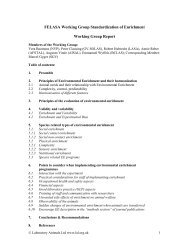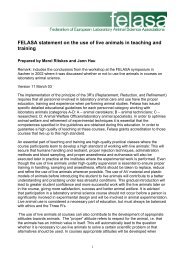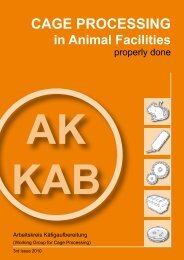CAGE PROCESSING in Animal Facilities - Felasa
CAGE PROCESSING in Animal Facilities - Felasa
CAGE PROCESSING in Animal Facilities - Felasa
- No tags were found...
You also want an ePaper? Increase the reach of your titles
YUMPU automatically turns print PDFs into web optimized ePapers that Google loves.
surfaces stay soil free. For an evenly spread of test soil<strong>in</strong>g on the surface, the test strip must be thoroughlydegreased (the use of alcohol alone is not sufficient; it is recommended to use fat solvents or laboratory detergents,or to process the test strip <strong>in</strong> an automated washer at approximately 60 °C). 0.1 ml of the test soil<strong>in</strong>gis applied evenly to each contam<strong>in</strong>ated area and dried for 24 hours at 22 °C ± 1 °C and a relative air humidityof 50% ± 10% (temperature and air humidity must be recorded <strong>in</strong> the test report). The test<strong>in</strong>g must be donewith<strong>in</strong> 10 days after the test strip was produced. It is recommended to store the test strip at room temperaturefree of contam<strong>in</strong>ation (e.g. <strong>in</strong> alum<strong>in</strong>ium foil or glass tubes). The number of organisms per contam<strong>in</strong>ated piecemust be high enough, consider<strong>in</strong>g the detection limit, to allow for evaluation of the reduction factor (at least 1x10 7 CFU/test strip). Contam<strong>in</strong>ated pieces can be acquired at, for example, SGS Germany GmbH, Hamburg.7.2.3.4 Evaluation of test stripsAfter the washer f<strong>in</strong>ished its cycle the test strips are detached under aseptic conditions (e.g. by mov<strong>in</strong>g eachwith sterilised tweezers). Each piece is then exam<strong>in</strong>ed visually for residues of test soil<strong>in</strong>g before be<strong>in</strong>g transferred<strong>in</strong>to a 10 ml phosphate buffer solution (PBS), with <strong>in</strong>activat<strong>in</strong>g substances, where applicable.Composition of the phosphate buffer solution (PBS)Solution A:16 g NaCl,0.4 g KCl,0.4 g KH 2PO 4To dissolve <strong>in</strong> 1600 ml distilled waterSolution B: 0.2 g CaCl 2To dissolve <strong>in</strong> 200 ml distilled waterSolution C: 0.2 g MgSO 4To dissolve <strong>in</strong> 200 ml distilled waterSolutions A to C require a separate Steam sterilisation. After cool<strong>in</strong>g down completely, they should be mixedunder sterile conditions, by add<strong>in</strong>g the <strong>in</strong>activat<strong>in</strong>g substance, where applicable.The test organisms are recovered by extract<strong>in</strong>g them from the test strips that were transferred <strong>in</strong>to test tubes.The extraction is done by putt<strong>in</strong>g the test tube racks on shak<strong>in</strong>g devices with a frequency of approximately 500rpm for at least 20 m<strong>in</strong>utes. After that, the number of organisms can be determ<strong>in</strong>ed from the shaken liquid. Itmust be <strong>in</strong>dicated what method was used.Parallel to that, the transport controls are equally transferred <strong>in</strong>to 10 ml PBS and analysed, without be<strong>in</strong>g treated<strong>in</strong> the washer.Valid methods for determ<strong>in</strong><strong>in</strong>g the number of organisms are:• dilution series and surface culture,• spiral plater.A suitable selective culture medium (e.g. Kanamyc<strong>in</strong> Escul<strong>in</strong> Acid Agar) can help suppress the grow<strong>in</strong>g ofother organisms. The <strong>in</strong>cubation time of the spiked culture media at 36 ± 1 °C is 48 hours. It must be <strong>in</strong>dicatedwhat methods were used for determ<strong>in</strong><strong>in</strong>g the number of organisms as well as what culture solutions and culturemedia were used.The reduction of organisms count results from the difference of the number of detected CFU of test organismson the treated test strips and from the average value of the three untreated test strips (transport controls). Thereduction factor must at least add up to 5 lg levels with 90% of the used test strips.7.3 Test procedures for wash<strong>in</strong>g and decontam<strong>in</strong>ation of water bottlesWith water bottles, the wash<strong>in</strong>g performance is assessed by means of test soil<strong>in</strong>g directly contam<strong>in</strong>at<strong>in</strong>g thebottle surface.Cage Process<strong>in</strong>g <strong>in</strong> <strong>Animal</strong> <strong>Facilities</strong> · 4th issue · 2013 53






